Week 4: Unit 3
11/09/11 15:18
Greek Verbs (continued)
Let’s look at the remaining tenses and paradigms of the Indicative, and the few tenses of the Subjunctive and Optative:
The perfect tense is identified by a reduplication of the initial syllable (most of the time) and the following endings, added to the fourth principle part:
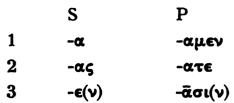
Thus for παιδεύω, we have the stem πεπαίδευκ- (front he fourth principle part), and with the endings we get:
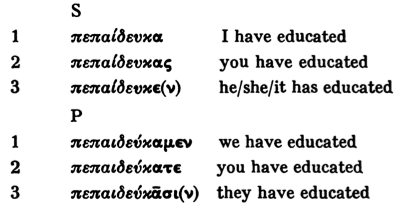
Remember these translations - you will always get credit for a perfect tense verb if you translate it with ‘have.’
For the pluperfect, we’ll add the past tense augment and the following endings to the fourth principle part:
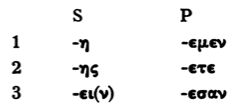
Thus for παιδεύω, we have the stem πεπαίδευκ-, to which we must add the ἐ- augment. With the pluperfect endings we get:
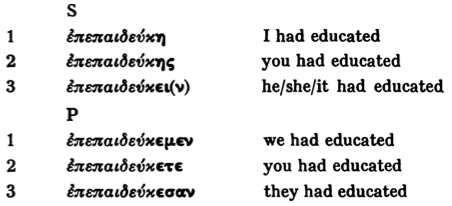
Remember these translations - you will always get credit for a pluperfect tense verb if you translate it with ‘had.’
Perfect Active Infinitive
To form the perfect active infinitive, simply remove the perfect 1st person ending form the 4th principle part and add -εναι:
πεπαιδεύκεναι - ‘to have educated’
Subjunctive and Optative Moods
These moods, unlike the Indicative, demonstrate that, from the speaker’s perspective, the action described is non-factual. There is not set translation for these moods - meaning will change depending on the clause in which the verb is used. For now, don’t worry about translating the various forms, just concentrate on learning the forms.
For the present active subjunctive, you add the following endings to the first principle part:

Thus for παιδεύω, we have the stem παιδεύ-, and with the endings we get:

For the aorist subjunctive active, we’ll add the same endings to the UNAUGMENTED aorist stem. Get rid of that ἐ- augment, and add your endings:

Celebrate! There is no Future Subjunctive (naturally, because the future is by its nature unsure and thus non-indicative).
For the present optative active, we’ll have a new sent of endings:

All we have to do is add these endings to the first principle part:

For the aorist, we’ll add on some new endings, also on to the UNAUGMENTED stem (the fourth principle part, without the ἐ- augment):

This leaves us with:
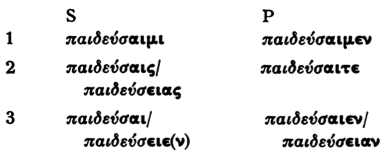
One final thing: in the optative forms, the final diphthongs -αι and -οι are LONG not SHORT, for the purposes of accentuation.
That’s about it! Later in the week we’ll look at sequence of moods and purpose clauses, our first clause which will provide a special translation for subjunctive and optative verbs.
Let’s look at the remaining tenses and paradigms of the Indicative, and the few tenses of the Subjunctive and Optative:
The perfect tense is identified by a reduplication of the initial syllable (most of the time) and the following endings, added to the fourth principle part:

Thus for παιδεύω, we have the stem πεπαίδευκ- (front he fourth principle part), and with the endings we get:

Remember these translations - you will always get credit for a perfect tense verb if you translate it with ‘have.’
For the pluperfect, we’ll add the past tense augment and the following endings to the fourth principle part:

Thus for παιδεύω, we have the stem πεπαίδευκ-, to which we must add the ἐ- augment. With the pluperfect endings we get:

Remember these translations - you will always get credit for a pluperfect tense verb if you translate it with ‘had.’
Perfect Active Infinitive
To form the perfect active infinitive, simply remove the perfect 1st person ending form the 4th principle part and add -εναι:
πεπαιδεύκεναι - ‘to have educated’
Subjunctive and Optative Moods
These moods, unlike the Indicative, demonstrate that, from the speaker’s perspective, the action described is non-factual. There is not set translation for these moods - meaning will change depending on the clause in which the verb is used. For now, don’t worry about translating the various forms, just concentrate on learning the forms.
For the present active subjunctive, you add the following endings to the first principle part:

Thus for παιδεύω, we have the stem παιδεύ-, and with the endings we get:

For the aorist subjunctive active, we’ll add the same endings to the UNAUGMENTED aorist stem. Get rid of that ἐ- augment, and add your endings:

Celebrate! There is no Future Subjunctive (naturally, because the future is by its nature unsure and thus non-indicative).
For the present optative active, we’ll have a new sent of endings:

All we have to do is add these endings to the first principle part:

For the aorist, we’ll add on some new endings, also on to the UNAUGMENTED stem (the fourth principle part, without the ἐ- augment):

This leaves us with:

One final thing: in the optative forms, the final diphthongs -αι and -οι are LONG not SHORT, for the purposes of accentuation.
That’s about it! Later in the week we’ll look at sequence of moods and purpose clauses, our first clause which will provide a special translation for subjunctive and optative verbs.